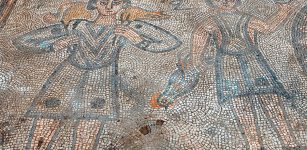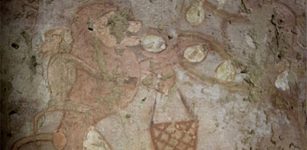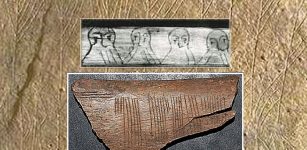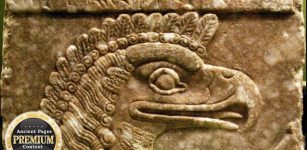Yam: Tyrannical Hydra-Like Sea Monster God Cast Out Of Heaven
A. Sutherland - AncientPages.com - Yam (Yamm), (in Hebrew, means ‘sea’) is best known from Canaanite tablets unearthed at Ugarit and related in myths to Baal, the son of the supreme god El, and the universal god of fertility who was titled ‘Prince, Lord of the Earth.’
Destruction of Leviathan, engraving by Gustave Doré, 1865. Credit: Public Domain
The tablets inform that at the beginning of time, Yam was awarded the divine kingship by El, the chief god of the pantheon - father of all the other gods “Creator/Possessor of Heaven and Earth” (except for Baal).
Yam, a tyrannical, monstrous deity of the sea and other watery realms, was in constant conflict with Baal. These two gods met each other in combat on the plains of heaven and, after his defeat, Yam was cast out of heaven and into the depths of chaos.
Despite what happened to him, he remained in conflict with Baal and wished to dethrone him to rule in heaven. So he came back from the depths beneath the seas to battle for heaven’s gates.
In some versions of the myth, Yam and Baal repeatedly kill each other, resurrect, fight again and die, only to return to life once more. This repeating mythological battle may symbolize furious winter sea storms, which usually calmed in the spring.
Goddess Astarte. Credit: A. Ocram - Public Domain
Some myths found in a fragmented ancient papyrus say that the goddess Astarte was deeply discontented by tributes Yam demanded from other gods. Yam threatened to flood the whole earth if he did not get what he wanted.
El instructed the craftsman-god, Kothar wa-Khasis, to build a palace on his (El’s) grounds and officially announced that his (eldest or favorite?) son is to be known as ‘El’s Beloved Yam’ and as Master, he probably authorizes Yam to banish Baal from his throne.
God El - King of the Gods. Gilded statuette of El from Megiddo. Credit: Daderot - Public Domain
But Yam still wanted more. He requested that the gods surrender Baal to be his bondservant. El finally agreed, but Baal refused and instead decided to meet Yam in a decisive battle.
After a furious fight, using two special weapons delivered to him by the craftsman Kothar, Baal managed to defeat Yam, scattering the pieces of his body. The battle was won, and now the kingship finally belonged to Baal.
In the Egyptian version of the story, the monster god Yam was defeated by Seth, with whom Baal was identified in the Ugaritic myth.
Yam is not clearly described in the available sources and has no clear appearance, though he seems to be serpentine in form.
Some believe that Yam may have had a great, seven-headed sea monster in his following, or he could also himself have been that monster.
According to some scholars, Yam is identical with the god Lotan (Hebrew: Leviathan) – a representation of a serpent or a many-headed dragon and is the model for Satan in the Biblical Book of Revelation (12:9).
Yam seems entirely motivated by rage, his actions are apparent, and he makes no secret of his disrespect for the other gods and their weak and clearly imperfect creations - humans.
Additionally, this figure is also associated with the Christian devil, with a serpent present in the Garden of Eden in the Book of Genesis, chapter 3.
Scholars know of no ancient Egyptian cult related to the monstrous Yam. However, it is known that Egyptian seafarers widely feared Yam. In addition, if we assume that Yam was also Satan, he must have been feared by many others as well.
Written by – A. Sutherland - AncientPages.com Senior Staff Writer
Updated on June 27, 2021
Copyright © AncientPages.com All rights reserved. This material may not be published, broadcast, rewritten or redistributed in whole or part without the express written permission of AncientPages.com
Expand for referencesSources:
Grottanelli, Kings and Prophets
J.B. Pritchard, Ugaritic Myths, Epic and Legends
More From Ancient Pages
-
 Sibylline Books: Ancient Prophecies Destroyed By Fire
Featured Stories | Feb 17, 2016
Sibylline Books: Ancient Prophecies Destroyed By Fire
Featured Stories | Feb 17, 2016 -
 Giants Roamed The Earth Millions Of Years Ago
Ancient Mysteries | Sep 30, 2015
Giants Roamed The Earth Millions Of Years Ago
Ancient Mysteries | Sep 30, 2015 -
 Missing Lines From Epic Of Gilgamesh Shed New Light On Humbaba
Artifacts | Oct 9, 2015
Missing Lines From Epic Of Gilgamesh Shed New Light On Humbaba
Artifacts | Oct 9, 2015 -
 The Indigenous Artists Keeping Ancient Rock Art Traditions Alive For Future Generations
Archaeology | Oct 3, 2024
The Indigenous Artists Keeping Ancient Rock Art Traditions Alive For Future Generations
Archaeology | Oct 3, 2024 -
 Magnificent Etruscan Underground Burial With Beautiful Artifacts Discovered In Aleria-Lamajone, France
Archaeology | May 13, 2022
Magnificent Etruscan Underground Burial With Beautiful Artifacts Discovered In Aleria-Lamajone, France
Archaeology | May 13, 2022 -
 Unknown 2,000-Year-Old Settlement Hidden In The Polish Tuchola Forest Revealed By LIDAR
Archaeology | Feb 18, 2019
Unknown 2,000-Year-Old Settlement Hidden In The Polish Tuchola Forest Revealed By LIDAR
Archaeology | Feb 18, 2019 -
 Mosaics Discovered In 1,600-Year-Old Church In Mardin Province,Turkey
Archaeology | Sep 22, 2020
Mosaics Discovered In 1,600-Year-Old Church In Mardin Province,Turkey
Archaeology | Sep 22, 2020 -
 Unsolved Mystery Of Gedi Ruins Protected By The ‘Old Ones’ – Why Did People Leave?
Civilizations | Apr 2, 2019
Unsolved Mystery Of Gedi Ruins Protected By The ‘Old Ones’ – Why Did People Leave?
Civilizations | Apr 2, 2019 -
 Tomb Of Hathor’s Priestess Hetpet Unearthed Near Pyramid Of Khafre, Cairo, Egypt
Archaeology | Feb 5, 2018
Tomb Of Hathor’s Priestess Hetpet Unearthed Near Pyramid Of Khafre, Cairo, Egypt
Archaeology | Feb 5, 2018 -
 Mysterious Viking Code Jötunvillur Deciphered By Norwegian Researcher
News | Feb 24, 2014
Mysterious Viking Code Jötunvillur Deciphered By Norwegian Researcher
News | Feb 24, 2014 -
 Chang’e: Chinese Goddess Of Moon And Immortality
Chinese Mythology | Aug 7, 2019
Chang’e: Chinese Goddess Of Moon And Immortality
Chinese Mythology | Aug 7, 2019 -
 Huge 40-Meter Long 16th Century Tunnel For Looting Was Exposed Inside Tower Tomb
Archaeology | Jul 15, 2019
Huge 40-Meter Long 16th Century Tunnel For Looting Was Exposed Inside Tower Tomb
Archaeology | Jul 15, 2019 -
 New Evidence Of The Destruction Of The Second Temple In The City Of David
Archaeology | Aug 5, 2023
New Evidence Of The Destruction Of The Second Temple In The City Of David
Archaeology | Aug 5, 2023 -
 On This Day In History: Battle Of Lissa Took Place In The Adriatic Sea – On July 20, 1866
News | Jul 20, 2016
On This Day In History: Battle Of Lissa Took Place In The Adriatic Sea – On July 20, 1866
News | Jul 20, 2016 -
 Ancient City Of Isaura And Zengibar Castle Used By The Hittites, Persians, And Romans
Archaeology | Jun 25, 2020
Ancient City Of Isaura And Zengibar Castle Used By The Hittites, Persians, And Romans
Archaeology | Jun 25, 2020 -
 Adapa – Why Did The Wise Apkallu Refuse The Gift Of Immortality?
Featured Stories | May 9, 2019
Adapa – Why Did The Wise Apkallu Refuse The Gift Of Immortality?
Featured Stories | May 9, 2019 -
 Sobek: A 2,500-Year-Old Mummified Nile Crocodile – On Display At The British Museum
Archaeology | Dec 9, 2015
Sobek: A 2,500-Year-Old Mummified Nile Crocodile – On Display At The British Museum
Archaeology | Dec 9, 2015 -
 Rare Ancient Boomerang Collection Sheds New Light On Australia’s Past
Archaeology | Nov 4, 2021
Rare Ancient Boomerang Collection Sheds New Light On Australia’s Past
Archaeology | Nov 4, 2021 -
 Traces Of Early Humans Discovered In Southern Iran
Archaeology | Sep 25, 2019
Traces Of Early Humans Discovered In Southern Iran
Archaeology | Sep 25, 2019 -
 Prehistoric Legacy Of The Mysterious Burnt City
Civilizations | Jan 22, 2021
Prehistoric Legacy Of The Mysterious Burnt City
Civilizations | Jan 22, 2021



